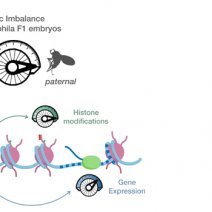Cis-acting variation is common across regulatory layers but is often buffered during embryonic development
S. Floc’hlay, E. Wong, B. Zhao, R. R Viales, M.Thomas-Chollier, D. Thieffry, D. A Garfield, E. E. M. Furlong*
Swann Floc’hlay, Emily Wong, Bingqing Zhao, Rebecca R Viales, Morgane Thomas-Chollier, Denis Thieffry, David A Garfield, Eileen E. M. Furlong*
Abstract
Precise patterns of gene expression are driven by interactions between transcription factors, regulatory DNA sequence, and chromatin. How DNA mutations affecting any one of these regulatory ’layers’ is buffered or propagated to gene expression remains unclear. To address this, we quantified allele-specific changes in chromatin accessibility, histone modifications, and gene expression in F1 embryos generated from eight Drosophila crosses at three embryonic stages, yielding a comprehensive dataset of 240 samples spanning multiple regulatory layers. Genetic variation (allelic imbalance) impacts gene expression more frequently than chromatin features, with metabolic and environmental response genes being most often affected. Allelic imbalance in cis-regulatory elements (enhancers) is common and highly heritable, yet its functional impact doesn’t generally propagate to gene expression. When it does, genetic variation impacts RNA levels through H3K4me3 or independently through chromatin accessibility and H3K27ac. Changes in RNA are more predictive of variation in H3K4me3 than vice versa, suggesting a role for H3K4me3 downstream of transcription. The impact of a substantial proportion of genetic variation is consistent across embryonic stages, with 50% of allelic imbalanced features at one stage being also imbalanced at subsequent developmental stages. Crucially, buffering, as well as the magnitude and evolutionary impact of genetic variants, are influenced by regulatory complexity (i.e., number of enhancers regulating a gene), with transcription factors being most robust to cis-acting, but most influenced by trans-acting variation.
Genome Res. 2020 Dec 11 ; gr.266338.120. doi:10.1101/gr.266338.120


